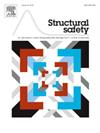The generalized first-passage probability considering temporal correlation and its application in dynamic reliability analysis
IF 6.3
1区 工程技术
Q1 ENGINEERING, CIVIL
引用次数: 0
Abstract
In the traditional up-crossing rate approaches, the absence of consideration for correlation among crossing events often results in significant inaccuracies, particularly in scenarios involving stochastic processes with high autocorrelation and low thresholds. To fundamentally address these issues and limitations, the probability density function of the first passage time represented by the high-dimensional joint probability density function was investigated, and the equiprobable joint Gaussian (E-PHIn) method is proposed to prevent the redundant counting of the same crossing event. The innovation of the developed method is that it accounts for the correlation among different time instances of the stochastic process and allows for direct integration to derive the first-passage probabilities. When dealing with stochastic processes with unknown marginal distributions, the method of moments was introduced, complementing the E-PHIn method. Meanwhile, corresponding dimensionality reduction strategies are offered to improve computational efficiency. Through theoretical analysis and case studies, the results indicate that the conditional up-crossing rate represents the probability density function of the first-passage time. The E-PHIn method effectively addresses the first-passage problem for stochastic processes with either known or unknown marginal probability density functions. It fills the gap in traditional up-crossing rate approaches within the domain of nonlinear dynamic reliability. For the example structures, the E-PHIn method demonstrates higher accuracy compared to traditional point-based PDEM. Compared to MCS, the E-PHIn method significantly improves analytical efficiency while maintaining high precision for low-probability failure events.
考虑时间相关性的广义首通概率及其在动态可靠度分析中的应用
在传统的上交叉率方法中,没有考虑交叉事件之间的相关性往往会导致显著的不准确性,特别是在涉及高自相关性和低阈值的随机过程的情况下。为了从根本上解决这些问题和局限性,研究了由高维联合概率密度函数表示的首次通过时间的概率密度函数,并提出了等概率联合高斯(E-PHIn)方法来防止同一交叉事件的重复计数。该方法的创新之处在于,它考虑了随机过程的不同时间实例之间的相关性,并允许直接积分来推导首次通过的概率。在处理边缘分布未知的随机过程时,引入矩量法作为E-PHIn方法的补充。同时,提出了相应的降维策略以提高计算效率。理论分析和实例分析表明,条件上交率是首次通过时间的概率密度函数。E-PHIn方法有效地解决了具有已知或未知边际概率密度函数的随机过程的首次通过问题。它填补了非线性动态可靠度领域中传统上交率方法的空白。对于实例结构,与传统的基于点的PDEM相比,E-PHIn方法具有更高的精度。与MCS相比,E-PHIn方法显著提高了分析效率,同时在低概率故障事件中保持了高精度。
本文章由计算机程序翻译,如有差异,请以英文原文为准。
求助全文
约1分钟内获得全文
求助全文
来源期刊

Structural Safety
工程技术-工程:土木
CiteScore
11.30
自引率
8.60%
发文量
67
审稿时长
53 days
期刊介绍:
Structural Safety is an international journal devoted to integrated risk assessment for a wide range of constructed facilities such as buildings, bridges, earth structures, offshore facilities, dams, lifelines and nuclear structural systems. Its purpose is to foster communication about risk and reliability among technical disciplines involved in design and construction, and to enhance the use of risk management in the constructed environment
 求助内容:
求助内容: 应助结果提醒方式:
应助结果提醒方式:


